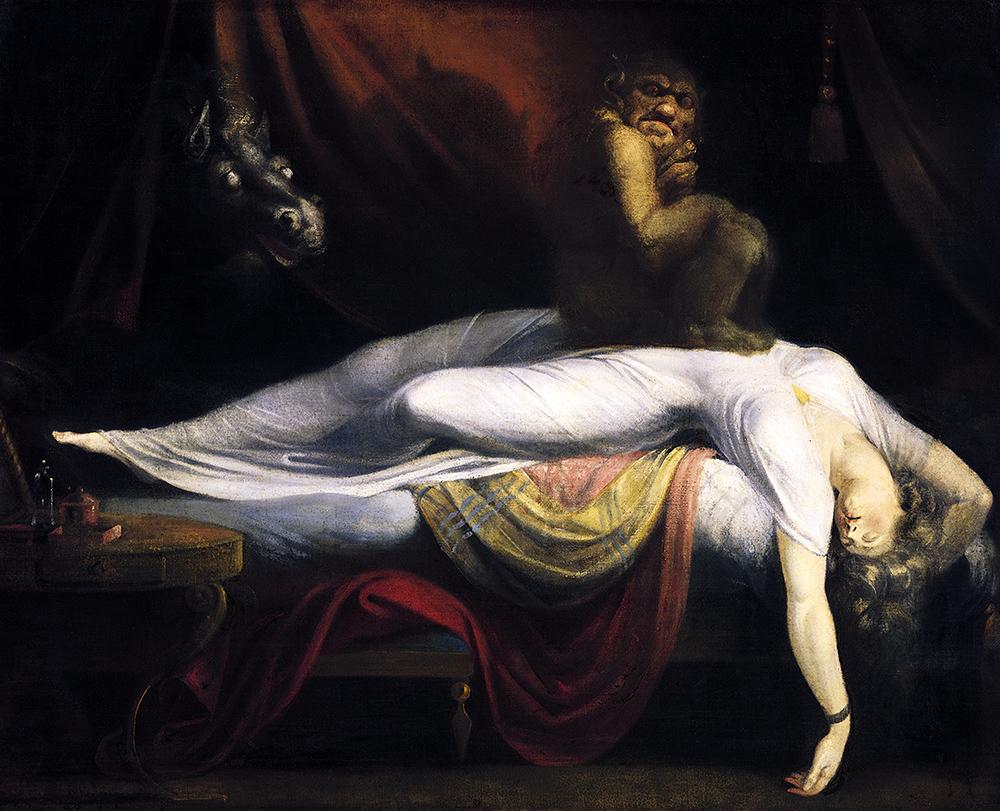History: The Nightmare by Henry Fuseli was painted in 1781 and was first shown to the public in 1782. He originally sold the painting for twenty guineas. Now, it is displayed at the Detroit Institute of Arts in the United States and is worth $3 - $4 million. The Nightmare is a very special painting, because it is one of the first to solely convey an idea, rather than a specific person or place. Henry Fuseli never revealed his exact intentions or meanings behind his painting. Socially, his painting was created during the “Age of Reason,” when most people had stopped believing in supernatural creatures. I think that this makes his use of the supernatural more interesting. I think that using supernatural creatures in his paintings was a way for Fuseli to step outside of the social norm. I think that he deliberately is pushing the viewers of his painting to explore other themes than what everyone else is already doing, or what is common.
The Creature: The figure sitting on the woman’s chest is described as an incubus. These spirts are said to lie on people in their sleep, or have intercourse with a woman while she is asleep. As previously stated, Fuseli never revealed his exact intentions behind this painting, and the painting itself certainly doesn’t either. Because the painting is not explicit or obvious, it leaves room for interpretation as to what the creature is doing there. The woman could simply be dreaming, but her dreams are definitely taking on terrifying forms.
The Horse: One thing that I didn’t notice right away was the horse in the background. According to John Knowles, who was Henry Fuseli’s friend and biographer, the horse was actually not present in the original drawing that Fuseli made, but was added to the painting later on. In this time, a mare was known as an evil sprit that tortures people while they sleep.
Anna Landolt: Some historians have suggested that The Nightmare may have a more personal meaning or interpretation to Henry Fuseli himself. It is inquired that the painting could be in response to his feelings for Anna Landolt. Anna was his romantic interest, but she was engaged to another man. It is inferred that his painting was his acknowledgement of his one-sided or unreturned love.
The Sublime: Fuseli was critiqued for his lack of moral lesson in The Nightmare. There wasn’t any reference to God or the bible. One review from The Morning Chronicle writes that “The Nightmare, by Mr. Fuseli like all his productions has strong marks of genius about it; but hag-riding is too unpleasant a thought to be agreeable to anyone, and is unfit for furniture or reflection – Qui bono?… Yet surely a disagreeable subject, well-executed, is preferable to the most engaging one ill-described.” This basically states that this was a disagreeable/controversial subject, and he did a bad job painting it. So, there were obviously people that weren’t fans of Fesuli’s work, as it was controversial. However, Fesuli was more concerned with the balance of horror and beauty, or the sublime, than the presence of God in his works.
Works Cited
Dilworth, Frances. “The Nightmare by Henry Fuseli: 3 Ways to Interpret His Most Famous Work.” TheCollector, 13 Jan. 2021, https://www.thecollector.com/henry-fuseli-the-nightmare/.
“Inside the Nightmare, Henry Fuseli's Horror Masterpiece.” Widewalls, https://www.widewalls.ch/magazine/henry-fuseli-the-nightmare.
“The Nightmare (1781).” The Nightmare, Henry Fuseli: Analysis, http://www.visual-arts-cork.com/famous-paintings/nightmare-fuseli.htm.
Paulson, Dr. Noelle. “Henry Fuseli, the Nightmare.” Smarthistory, https://smarthistory.org/henry-fuseli-the-nightmare/.


